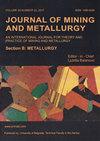Effect of FeO content on melting characteristics and structure of nickel slag
IF 1
4区 材料科学
Q3 METALLURGY & METALLURGICAL ENGINEERING
Journal of Mining and Metallurgy Section B-Metallurgy
Pub Date : 2022-01-01
DOI:10.2298/jmmb220317024m
引用次数: 1
Abstract
A great deal of nickel slag containing a lot of Fe in the form of FeO is produced in the process of nickel smelting. The effect of FeO content on the melting characteristics and structure of nickel slag is studied via thermodynamic calculation and experiments, with the nickel slag of water quenching furnace as raw material, which is simplified to CaO-SiO2-FeO-MgO slag system. The results are shown as follows: with the increasing of FeO content, the precipitated primary phase changes from melilite to olivine. The liquidus temperature, softening temperature, hemispheric temperature, flow temperature, viscosity and critical viscosity temperature of slag system tends to decrease gradually, but the solid phase temperature tends to decrease first and then increase. The centre of [SiO4]4- tetrahedron symmetric stretching vibration band in the slag system moves to the low wave number region. The mole fraction of O0 in the slag decreases continuously, the mole fraction of O- and O2- increases. The complex silicon-oxygen tetrahedron structure gradually disintegrates and the structural unit tends to be simple.FeO含量对镍渣熔炼特性及组织的影响
在镍冶炼过程中产生大量含大量FeO形式铁的镍渣。以水淬炉镍渣为原料,简化为CaO-SiO2-FeO-MgO渣体系,通过热力学计算和实验研究了FeO含量对镍渣熔融特性和结构的影响。结果表明:随着FeO含量的增加,析出的原生相由千英石转变为橄榄石;渣系液相温度、软化温度、半球温度、流动温度、粘度和临界粘度温度呈逐渐降低的趋势,而固相温度呈先降低后升高的趋势。渣系[SiO4]4-四面体对称伸缩振动带中心向低波数区移动。渣中O0的摩尔分数不断降低,O-和O2-的摩尔分数不断增加。复杂的硅氧四面体结构逐渐瓦解,结构单元趋于简单。
本文章由计算机程序翻译,如有差异,请以英文原文为准。
求助全文
约1分钟内获得全文
求助全文
来源期刊
CiteScore
2.00
自引率
40.00%
发文量
19
审稿时长
2 months
期刊介绍:
University of Belgrade, Technical Faculty in Bor, has been publishing the journal called Journal of Mining and Metallurgy since 1965 and in 1997 it was divided in two independent journals dealing with mining and metallurgy separately. Since 2009 Journal of Mining and Metallurgy, Section B: Metallurgy has been accepted in Science Citation Index Expanded.
Journal of Mining and Metallurgy, Section B: Metallurgy presents an international medium for the publication of contributions on original research which reflect the new progresses in theory and practice of metallurgy. The Journal covers the latest research in all aspects of metallurgy including hydrometallurgy, pyrometallurgy, electrometallurgy, transport phenomena, process control, solidification, mechanical working, solid state reactions, materials processing, surface treatment and relationships among processing, structure, and properties of materials.

 求助内容:
求助内容: 应助结果提醒方式:
应助结果提醒方式:


